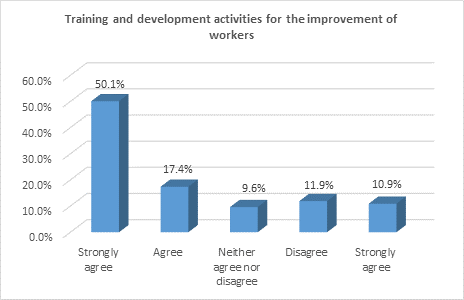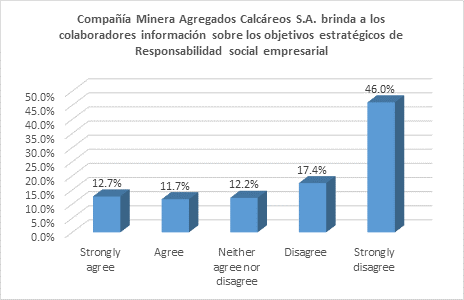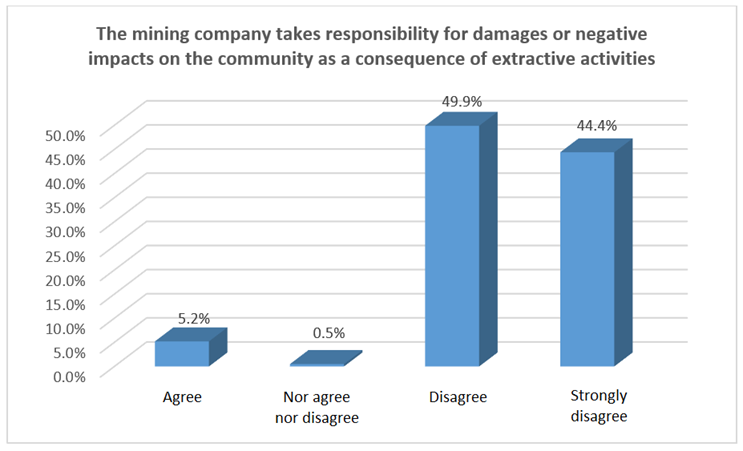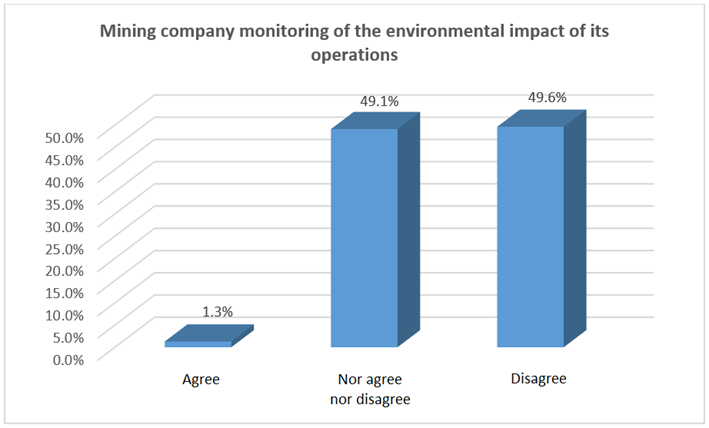Services on Demand
Journal
Article
Indicators
-
 Cited by SciELO
Cited by SciELO
Related links
-
 Similars in
SciELO
Similars in
SciELO
Share
Industrial Data
Print version ISSN 1560-9146On-line version ISSN 1810-9993
Ind. data vol.25 no.2 Lima July/Dic. 2022
http://dx.doi.org/10.15381/idata.v25i2.18924
Production and Management
Corporate Social Responsibility and Community Development Surrounding a Mining Company, 2018
1Chemical engineer from Universidad Nacional de San Agustín de Arequipa (Arequipa, Peru). Currently working at Compañía Minera Agregados Calcáreos S. A. (Lima, Peru). E-mail: victor.carlin@yahoo.com.pe
In countries where mining activity is one of the most important sources of income, there is a constant interest in identifying those management practices that make it possible to satisfy the needs and perspectives of the population, among which corporate social responsibility deserves special mention. The purpose of this research was to establish the correlation between corporate social responsibility and community development in the environment surrounding a mining company. This was a non-experimental research study with a correlational design and non-probabilistic sampling; the sample consisted of the company’s workers and the local inhabitants. The technique used was the survey, and the questionnaire was used as the data collection instrument, which met the criteria of validity and reliability (Cronbach’s alpha coefficient = 0.833). Social responsibility dimensions such as “ethics” (information transparency), “sustainability” (participation and mutual benefit), “human capital” (human resources management and occupational safety) and “safety” (change adjustment and impact management) stand out from the instrument, as they are specific to the reality of the study. From the results, it is evident that there is a high correlation (r = 0.964) between the two research variables, social responsibility and community development, due to the high and significant correlation between the two.
Keywords: corporate social responsibility; development; sustainability; human capital; security
INTRODUCTION
Since their foundation, the vision of mining companies has undergone a major change, as they have gone from being organizations that were formed only for the pursuit of profit and a strong emphasis on the financial aspect to become entities with a marked concern for the political, economic, social and environmental factors that have influence their actions. The Green Paper of the European Commission defines corporate social responsibility (CSR) as the “voluntary integration by companies of social and environmental concerns in their business operations and relations with their partners” (Escuela Superior de Administración y Dirección de Empresas, 2015, p. 13). Mining companies today therefore engage in greater exchanges with society, have moved away from that purely monetary relationship and interact with a range of stakeholders (suppliers, customers, employees, communities, public and private bodies), recognizing that the changes brought about by technology and communications demand innovation. These facts place the business organization in a complex and dynamic environment that cannot be detached from said situations; on the contrary, management must assume a strategic and competitive position in order to remain in business.
The concept of corporate social responsibility is constantly used within the social framework as a strategy and strategic management concept, which is part of organizational philosophy, with mining companies no exception as their activities impact the entire community.
The relationship between the mining company and the surrounding environment is key to achieving “socially acceptable” operations. All organizations and individuals involved in mining know that the greater the social recognition of their projects, the greater the possibility that it will be sustainable in the long term. Thus, corporate social responsibility plays a major role and goes hand in hand with the proper management of the key factors: mining, society and the environment. Therefore, corporate responsibility consists of sharing with the community the potential benefits of their resources so that they can also make proper use of them (Arias et al., 2013). Efficiently managed social responsibility projects yield considerable local benefits; to cite an example at the international level, in Ghana, the mining company Gold Fields Ltd. trained a group of people to give lectures on community health and basic care for people (Yankson, 2010).
For this study, the mining company is committed to corporate governance to ensure good products and better services for the peace of mind of its customers, and to protect the environment, physical safety, health and well-being of its employees, as well as that of its direct business partners. It is also responsible for promoting and strengthening relations with the surrounding communities, strives to maintain minerals as environmentally sustainable materials, and helps to reduce their possible negative effects. As for the implementation of the social responsibility plan, it involves ensuring its monitoring, control and compliance, as well as the areas of action that include ethical values and principles, working and employment conditions, community relations and environmental protection. Regarding the implementation strategy of the plan, it considers including environmental control measures, that is, preventive measures to avoid the occurrence of multiple impacts identified, from the design stage to the implementation stage (Bateman & Snell, 2015).
The Environmental Management Division in the municipalities is a key actor for the fulfillment of the social responsibility plans, as it is responsible for waste management and the administration and responsible growth of parks and gardens for public use. It is also responsible for promoting knowledge of an environmental culture, promoting the classification at the source, reuse and recycling of solid waste, implementing environmental strategies in their area of responsibility, promoting sustainable environmental education on natural resources and the protection of ecosystems, and encouraging community participation to ensure a healthy environment through public services provided in an adequate and efficient manner.
For all of the above reasons, it is important to determine the level of relationship between CSR and community development from the perspective of the residents where the mining site is located, on the understanding that only those who directly benefit from the company's activities can judge the performance of the mining company. Social conflicts are recurrent in mining areas, so it is necessary to identify the variables that comprise social responsibility and their positive valuation to implement the action plans set forth by the municipal government aimed at achieving greater community development.
This research study is justified by the existence of environmentally harmful activities conducted by organizations that operate in the mining area, such as the contamination of water sources (rivers), combined with the negligence of the authorities regarding environmental issues. The mining company should be aware of this problem and guide the municipality through the management of CSR in order to assess its impact on the sustainable development of cities and towns, and obtain its social permit. Attention should be drawn to the fact that CSR is a matter of extreme concern, in view of the fact that research or observations on the mining industry have shown that mining professionals spend little more than 50% of their work on issues related to social responsibility; In other words, the mining industry has become increasingly aware of the obligation to safeguard the environment and to have a constructive relationship with the social environment and ensure the sustainability of inhabited places located nearby mining environments (Berbel et al., 2014).
Corporate Management
A company must have its own management methodology or philosophy to clearly state its operations and achieve the objective set out as the reason for its existence; therefore, today, it is essential for a company to have a vision, mission, goals, policies, strategies and values, and to guide the actions undertaken in the performance of its functions (ESADE, 2015).
According to Francés (2013), práctica de la gestión (dirección) en las últimas décadas ha llevado a la adopción de misión, visión y valores. Este es un criterio de largo plazo que se puede utilizar para definir la dirección que la empresa quiere imprimir [management (direction) practice in recent decades has led to the adoption of mission, vision and values. This is a long-term criterion that can be used to determine the direction the company wants to take] (p. 37).
Social Responsibility
According to David (2013), collective obligation has become an important factor in defining a company’s mission, and social issues must be addressed directly and indirectly in the formulation of strategies. Similarly, Guédez (2013) expressed his view on ethics and corporate social responsibility, by proposing the values that leaders undertaking business commitments should possess: honesty, implying sincerity, sympathy and social sensitivity; caring behavior, implying concern for the behavior of others; humility, related to professional ambition, but modest demeanor; pragmatism, portrayed in the sense of achievement and with a tendency to act; and courage, referring to the ability to control risks and address their causes.
Corporate social responsibility is the strategic foundation for companies to contribute to the sustainable progress of the community. According to the Brundtland Report published by the United Nations, sustainable development is a way of satisfying current human needs without compromising the resources of future generations (Organización de las Naciones Unidas, 1987).
Corporate Social Responsibility Strategy
A properly planned and managed corporate social responsibility strategy can contribute to improving business potential; emphasis should be drawn to the benefit of recognizing opportunities and threats in order to identify and develop innovative ventures in new and/or existing markets with an all-inclusive effect for the entire population (Canessa & García, 2015). The raison d'être of corporate social responsibility is to develop tools to implement socially responsible practices while companies or organizations engage in their own activities. Corporate social responsibility calls for the establishment of a collective, moral and environmental regulation supported by updated rules of the jurisdiction where the company’s operations or business are based (Lapa, 2014).
The development of the extractive industry in countries rich in mineral resources and where there is evidence that they are efficiently managed will be a driving force for the sustained growth of the poorest local population; a key indicator of sustained growth is the overcoming of conflicts between the companies responsible for the extraction of minerals and the communities living near the site (Ministerio de Energía y Minas, 2011), for which it is of vital importance to devise and implement corporate social responsibility strategies.
Community Development
The term community refers to a group of people whose members share a common trait, interest, elements or function based on a sense of belonging, and are located in a specific geographic space in which individuals interact more intensely with each other. Montero (2007) defines the term as an ever-changing and evolving grouping (variable in number), that generates a sense of ownership and social identity through interaction; members become aware of themselves as a whole, and are strengthened as social unit with potential.
Communities are linked to ecology through biocenosis (also known as biological or ecological community), understood as the group of biological populations of any species (plant and animal) that coexist in a specific area (biotope) that provides the necessary surface conditions for their survival. Therefore, a community is the group of animal and plant populations that occupy a given territory and interact with each other, thus, it is an ecosystem. In this context, the population has the right and obligation to care for and preserve the environment (Otero, 1998).
It is for this reason that community development is understood as a technique and social practice where individuals in an associative environment consciously intervene in the diagnosis, planning and execution of community programs to improve the standard of living of both the individual and the group they belong to (Carvajal, 2011); authorities are responsible for ensuring compliance with them via the elaboration, implementation and evaluation of action plans to achieve the vision, mission, objectives, strategies, monitoring and results for the good of the community.
Corporate Social Responsibility and Community Development
Corporate social responsibility is a driving force that urges countries around the world to adopt measures to address the most pressing problems such as poverty and environmental care, and advocates for people to live in a world of peace and wellbeing. Research studies similar to that of Menéndez (2018) concluded that corporate social responsibility enables the development of the surrounding community, as it makes development channels viable, generates employment and insertion of residents into the productive chain and contributes to the construction of infrastructure, among its most noteworthy contributions.
METHODOLOGY
A quantitative approach and a non-experimental design were used for this study; it was cross-sectional, as it was measured at a single moment in time; and it was descriptive-correlational, as it shows the relationship between two or more levels, ideas or parameters in a single sample (Dugarte, 2018). It also conforms to the hypothetico-deductive method, as it allows studying and obtaining precise information on some phenomenon that is to be examined (Hernández et al., 2018).
The population was comprised of 2500 inhabitants of the district of Los Olivos, Lima, Peru, an area under mining impact. The sample consisted of 375 residents and 10 administrative employees; simple random sampling was used. A survey was used as the research technique (Carrasco, 2006), because it is a valid method for query, exploration and collection of data for this research type.
The research instrument was a questionnaire that contained the variables “CSR” and “community development” and consisted of 22 items with positive statements for each of the dimensions and indicators, such as “ethics” (information transparency), “sustainability” (participation and mutual benefit), “human capital” (human resources management and job security), “safety” (change adjustment and impact management) and “community development”. A Likert scale with responses such as never, almost never, sometimes, almost always and always was used. A Cronbach’s α coefficient of 0.833 indicates the high reliability of the instrument. Rho Spearman’s correlation coefficient, a nonparametric version of Pearson’s coefficient based on the data parameters instead of the actual values, was used to process the data; it is suitable for ordinal data and for values grouped in ranges that do not meet the assumption of normality.
RESULTS
Results showed that 50.1% of the workers acknowledge the mining company’s efforts to train and enhance their technical skills (Figure 1); however, 46% of the workers expressed their dissatisfaction with the way information related to the strategic objectives of corporate social responsibility is disseminated (Figure 2).

Source: Prepared by the author
Figure 1 The mining company carries out training and development activities to improve the skills of its workers.

Source: Prepared by the author
Figure 2 The mining company briefs employees on the strategic objectives of corporate social responsibility.
Respondents have a negative opinion of the mining company regarding responsible management. As shown in Figure 3, 49.9% of respondents “agree”" and 44.4% “strongly agree” that the company does not acknowledge its responsibility for the damages and negative impacts on the community as a result of the extractive activities it conducts; furthermore, 49.6% believe that the company does not monitor the environmental impact of its operations (Figure 4).

Source: Prepared by the author
Figure 3 The mining company takes responsibility for damages or negative impacts on the community as a consequence of extractive activities.

Source: Prepared by the author
Figure 4 Control levels are in place to monitor the environmental impact of the company’s operations.
The general hypothesis (H1) of the research study was as follows: Social responsibility is significantly related to community development in the mining company’s environment, 2018.
At a significance level α = 0.05 (95% confidence), and using Pearson’s Chi-square as test statistic under the premise that If | r | (correlation of Ch2) > 0.95, the relationship is established. A value of 0.962 was obtained, that is 96.2%, with a degree of freedom of 0.038 or 3.8%, thus validating the hypothesis that proposes that corporate social responsibility is significantly related to community development in the mining company’s environment (Table 1).
Table 1 Symmetric Measures: Corporate Social Responsibility * Community Development.
| Value | Asymp. Std. Errora | Approx. Tb | Approx. Sig. | ||
|---|---|---|---|---|---|
| Interval by Interval | Pearson’s R - Significance | 0.962 | 0.960 | 0.690 | 0.038(c) |
| Ordinal by Ordinal | Pearson Correlation(*) | 0.964 | 0.956 | 0.690 | 0.034(c) |
| N of Valid Cases | 385 | ||||
Source: Prepared by the author.
a. Assuming the alternative hypothesis with significance(*) in Pearson.
b. Using the asymptotic standard error assuming the alternative hypothesis.
c. Based on normal approximation.
DISCUSSION
Achieving community development relies to a large extent on efficient management of corporate social responsibility by the mining company, as by understanding the needs of the environment where mining activities are performed, local residents will have a positive opinion of their business practice, unlike in this research. Ensuring community development does not necessarily involve focusing on a single core theme; as Souza et al. (2001) demonstrated, there are other activities that can be fostered in these localities, such as business practices.
Job security, change adjustment and the work of human talent (Human Resources) corresponding to corporate social responsibility are related to the community development managed by the municipal government. Authorities must engage in resource conservation, including human beings, through adequate competitive training in a suitable physical and working environment. As stated by Moya (2017), human capital has an impact on the corporate social responsibility of Peruvian industrial companies because it is an instrument to monitor the optimal performance of the company with respect to social responsibility management. Accordingly, in this particular case of human resource management, respondents mentioned that applicable measures should consider continuous education, expert training, optimal management of organizational information and the pursuit of greater unity between work, family and the individual; the different skills of workers, fair pay, participation in the company’s interests or business behavior, and concern for technical support and protection in the work environment should also be promoted.
Training, health and essential services in households are the basic components of adequate social responsibility. Similar data can be found in Guerra et al. (2015), who conclude that the public and private sectors must coordinate permanently in order to achieve greater communal development.
It is well-known that the preservation of resources such as water, air, land and biodiversity depends on the actions taken by authorities as well as public, private and individual organizations. In the opinion of Méndez (2011), companies responsible for the exploitation of resources of a given community should aim to improve the quality of life of its members, increase employment and care for the environment; therefore, monitoring compliance with corporate social responsibility activities should be accompanied by the implementation of an action plan for community development that allows organizations to protect the environment through various public or private organizations.
CONCLUSIONS AND RECOMMENDATIONS
Coordinating the company’s social responsibility activities in the management of human resources, industrial health and safety, and change adjustment is related to community development; therefore, this study attempted to demonstrate the importance of the issue from the point of view of the population living nearby the mining area of influence and of the workers. It was demonstrated that a direct and significant correlation exists between corporate social responsibility and community development, and therefore the Government, represented by the local government, should oversee the actions of the mining company. Ensuring that the population perceives the mining company to be conducting its activities in a responsible manner is the shared obligation of the company and the municipal government, in order to achieve community development, regardless of the type of corporate or non-corporate activities being conducted.
Corporate social responsibility and community development are issues of permanent concern for the academic and business worlds, as it is necessary to identify which variables are subject to valuation by the population, even more so in mining-influenced environments, which are already complex and subject to a variety of conflicts. Thus, it is recommended that future researchers focus on identifying key social responsibility factors to meet the expectations of the population in the interest of achieving greater equity and the development of the people.
REFERENCIAS
Arias, V., Lovera, D., Puente, L. y Calderón, M. (2013). Contexto de la responsabilidad social minera y la gobernabilidad. Revista del Instituto de Investigaciones de la Facultad de Minas, Metalurgia y Ciencias geográficas, 12(23), 59-66. [ Links ]
Bateman, T., y Snell, S. (2015). Administración: Un nuevo panorama competitivo. México D. F., México: McGraw-Hill/Interamericana. [ Links ]
Berbel, G., Reyes, J., y Gómez, M. (2014). La responsabilidad social en las organizaciones (RSO): Análisis y comparación entre guías y normas de gestión e información. Innovar, 17(29). [ Links ]
Caballero, S. y Villarán, A. (2011). Responsabilidad social empresarial: ¿Por qué? Justificación deontológica de la responsabilidad social empresarial. Journal of Business, 3(1), 44-57. [ Links ]
Carrasco, S. (2016). Metodología de la investigación científica. Lima, Perú: Editorial San Marcos. [ Links ]
Carvajal Burbano, A. (2011). Apuntes sobre desarrollo comunitario. Universidad de Málaga, España. [ Links ]
David, F. (2013). Conceptos de Administración estratégica (9ª ed.). México D. F., México: Pearson Hall. [ Links ]
Dugarte, A. (2018). Repensar en la investigación educativa de la nueva era. (Ponencia presentada en la III Jornada de Investigación Humanística y Educativa de la Facultad de Ciencias de la Educación). Revista Ciencias de la Educación, 1(27), 99-108. [ Links ]
Escuela Superior de Administración y Dirección de Empresas. (2015). Libro verde de la comisión europea. Fomentar un marco europeo para la responsabilidad social de las empresas. Comunicación de la comisión relativa a la responsabilidad social de las empresas: una contribución empresarial al desarrollo sostenible. Barcelona, España: Estudi6. [ Links ]
Francés, A. (2013). Estrategia para la empresa en América latina (2ª ed.). Caracas, Venezuela: Ediciones IESA. [ Links ]
Canessa, G., y García, E. (2015). El ABC de la Responsabilidad Social Empresarial en el Perú y en el Mundo. Lima, Perú: Siklos S. R. Ltda. [ Links ]
Guédez, V. (2013). Ser confiable. Responsabilidad social y reputación empresarial. Caracas, Venezuela: Planeta. [ Links ]
Guerra, F., Higuera F, K., Molina, F., y Villagrán, P. (2015). Estudio comparativo sobre responsabilidad social entre empresas y países. (Seminario para optar al título de ingeniero comercial). Universidad de Chile, Santiago de Chile. [ Links ]
Hernández, R., Fernández, C. y Baptista, P. (2018). Metodología de la investigación (5ª ed.). México D.F, México: Mc Graw Hill Interamericana. [ Links ]
Lapa, L. (2014). La responsabilidad social empresarial frente a la colectividad laboral en el Perú. (Tesis doctoral). Universidad San Martín de Porres, Lima. http://www.repositorioacademico.usmp.edu.pe/bitstream/usmp/1135/1/lapa_s.pdf [ Links ]
Méndez, J. (2011). Análisis de la responsabilidad social empresarial del Ingenio San Antonio en la contribución del desarrollo local sostenible del Municipio de Chichigalpa, durante el periodo 2009-2010. (Tesis doctoral). Universidad Nacional Autónoma de Nicaragua, León; Universidad de El Salvador, UES-FMP, y Universidad de Alcalá de Henares. https://ageconsearch.umn.edu/record/119683/files/Tesis%20Francis%2011.pdf [ Links ]
Menéndez, L. (2018). Incidencia de la responsabilidad social corporativa en el desarrollo sostenible de la minería en Arequipa. Caso: Compañía Minera Caravelí 2016. (Tesis de grado). Universidad Nacional San Agustín de Arequipa, Arequipa. [ Links ]
Ministerio de Energía y Minas. (2011). Portal institucional sobre la Norma Técnica Peruana ISO 26000. Plan Nacional de Acción Ambiental (2011). https://www.minam.gob.pe/wp-content/uploads/2013/08/plana_2011_al_2021.pdf [ Links ]
Montero, M. (2007). Introducción a la psicología comunitaria. Buenos Aires, Argentina: Paidós. [ Links ]
Moya, J. (2017) Responsabilidad social empresarial de la gerencia servicios públicos de la Municipalidad de San Martín de Porres, 2017. (Tesis de maestría). Universidad César Vallejo, Lima. http://repositorio.ucv.edu.pe/bitstream/handle/20.500.12692/8866/Moya_AJL.pdf?sequence=1&isAllowed=y [ Links ]
Organización de la Naciones Unidas. (1987). Informe de la Comisión Mundial sobre el Medio Ambiente y el Desarrollo. Nota del Secretario General. http://www.ecominga.uqam.ca/PDF/BIBLIOGRAPHIE/GUIDE_LECTURE_1/CMMAD-Informe-Comision-Brundtland-sobre-Medio-Ambiente-Desarrollo.pdf [ Links ]
Otero, A. (1998). Medio ambiente y educación, capacitación en educación ambiental para docentes. Buenos Aires, Argentina: Ediciones Novedades Educativas. [ Links ]
Souza, S., Cheaz, J., Santamaría, J., Mato, M., y León, A. (2001). La dimensión de estrategia en la construcción de la sostenibilidad institucional. San José, Costa Rica: Proyecto ISNAR "Nuevo Paradigma". [ Links ]
Yankson, P. W. K. (2010). Gold mining and corporate social responsibility in the Wassa West district, Ghana. Development in Practice, 20(3), 354-366. https://doi.org/10.1080/09614521003709965 [ Links ]
Received: October 15, 2020; Accepted: August 02, 2022











 text in
text in 



